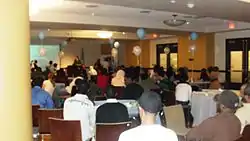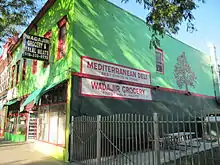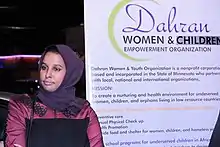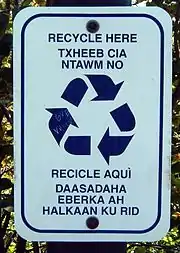History of Somalis in Minneapolis–Saint Paul
Somalis are an ethnic group in the Minneapolis–Saint Paul (Twin Cities) urban area and makes up the largest Somali diasporas in the US. As of 2018, almost 103,000 people born in Somalia are living in Minnesota, and about 194,000 Minnesotans speak Somali, Amharic or a related language at home. [1] [2]
| Part of a series on |
| Ethnicity in Minneapolis-Saint Paul |
|---|
|
|
|
History

Ethnic Somalis first emigrated to the Twin Cities as voluntary migrants in the 1980s and earlier. Other Somalis arrived in the United States after the start of the civil war in Somalia during the early 1990s, or from other parts of Greater Somalia.[3][4] Many of the newer arrivals moved to Minnesota through voluntary agencies (VOLAGS), who helped them settle in.[5][6] Somalis who had arrived earlier also assisted the more recent immigrants.[3]
Somalis in the Twin Cities and elsewhere in the United States often send resources to their extended families abroad, remittances that were facilitated by the signing of the Money Remittances Improvement Act.[7] Following a greatly improved security situation in Somalia in 2012, many Somali U.S. residents have also begun returning to Mogadishu and other parts of the country.[8] A few of the homeward-bound immigrants along with some American-born associates have been sought and/or prosecuted for allegedly providing material support to the Al-Shabaab and Islamic State political militant groups.[9][10] However, according to intelligence officials, fewer expatriates were joining the groups' ranks by late 2013.[11][12] Most of the returnees have instead repatriated for investment opportunities and to take part in the ongoing post-conflict reconstruction process in Somalia. Participating in the renovation of schools, hospitals, roads and other infrastructure, they have played a leading role in the capital's recovery and have also helped propel the local real estate market.[8]
Demographics

In early 2016, the Minnesota Demographers Office gave an estimate that there are between 190,200 and 252,400 Somalis in Minnesota, although some from the Somali community put the number as high as 240,000.[13] These estimates include people born in Somalia and of Somalia descent. The majority of the population are from the Darod's sub-clans, Majeerteen, Marehan, Ogaden, Dhulbahante, Leelkase, Warsangeli, Awrtable, Jidwaaq, Hawiye's sub-clans, Duduble, Abgaal, Xawaadle, Habar Gidir, Gaaljecel, Dagoodiye, and Dir subclans Gadebuursi, Ciise,etc. Somalis in Minnesota reside throughout the Twin Cities metropolitan area and the surrounding towns. Many Somalis inhabit Minneapolis' Cedar-Riverside neighborhood, particularly newly arrived immigrants. Somali professionals often move to the suburbs to raise their children in a more secure environment away from the inner city. Although Somalis have established ethnic enclaves, there is an easy commute between Somali areas and the wider metropolis.[3]
Commerce

Somalis in Minnesota have established many community enterprises. In 2006, they accounted for $164–$494 million in purchasing power and owned 600 businesses.[14] Minneapolis in particular hosts hundreds of Somali-owned and operated commercial ventures. Stalls inside several Somali shopping malls (carmal mall, etc.) offer everything from halal meat, to leather shoes, to clothing for men and women, as well as gold jewelry, money transfer or hawala offices, banners advertising Somali films, video rental stores fully stocked with nostalgic love songs not found in the mainstream supermarkets, groceries and boutiques.[15] Workplaces in the state have in turn grown more culturally sensitive and accommodating of differing religious traditions.[16] In 2018, Minneapolis officials named a new, innovative shared-use pathway near downtown Samatar Crossing in recognition of the Somalia-born Hussein Samatar's many civic contributions to Minneapolis.[17]
Community organizations

The Somali community in Minnesota is represented by various Somali-run organizations. Among these are the Confederation of Somali Community in Minnesota (CSCM) and Somali American Parent Association (SAPA), which offer a number of social services to the state's resident Somalis.[18][19]
This support system within the Somali community originates from a sense of shared responsibility towards other Somalis. The Somali community organizations provide ESL classes, job finding, legal advocacy and union services to their constituents.[3]
In October 2014, Minneapolis became the sister city of Bosaso, the third-largest city in Somalia.[20]
Politics
Politically, a Somali American Caucus in the Minnesota Democratic–Farmer–Labor Party (DFL) was formed to represent the Somali community.[21] As of 2012 a Somali American also chaired the Republican Party's Immigrant Relations Committee in Minnesota.[22]
In August 2018, Ilhan Omar won the Democratic primary for Minnesota's 5th congressional district. In November 2018, she was elected to the US House of Representatives, becoming the first Somali-American elected to Congress.
Notable residents
- Abdirizak Haji Hussein Former Prime Minister of Somalia 1964-1968
- Mohamed Abshir Former head of Somali Police in 1960s
- Saleeban Awaale Liibaan Former head of Somali Commercial Bank
- Abdi Warsame, politician, member of the Minneapolis City Council
- Abdirizak Bihi, social activist
- Anisa Hajimumin, politician, Minister of Women & Family Affairs of Puntland
- Fathia Absie, broadcaster, writer and filmmaker
- Nuruddin Farah, writer
- Saado Ali Warsame, singer-songwriter
- Sahra Noor, social activist and entrepreneur
- Ilhan Omar, politician, member of US House of Representatives
- Saciido SHaie, social activist
- Abdi Phenomenal, Poet, Playwright, Artistic Director
- Isra Hirsi, Climate Change Activist
- Hudda Ibrahim, Author, business woman, Mentor, Community Leader, Instructor
- Hussein Samatar, politician, banker and community organizer.
References
- Rutledge, Doug (2008). The Somali Diaspora: A Journey Away. University of Minnesota Press. ISBN 978-0-8166-5457-4.
Notes
- "B05006 Place of Birth for the Foreign-Born Population in the United States - Minnesota - 2018 American Community Survey 1-Year Estimates". U.S. Census Bureau. July 1, 2018. Retrieved September 9, 2020.
- "B16001 Language Spoken at Home by Ability to Speak English for the Population 5 Years and Over - Minnesota - 2018 American Community Survey 1-Year Estimates". U.S. Census Bureau. July 1, 2018. Retrieved September 9, 2020.
- Rutledge, p.135.
- Barkan, Elliott Robert (editor). Immigrants in American History: Arrival, Adaptation, and Integration. ABC-CLIO, 2013. ISBN 1598842196, 9781598842197. p. 693.
- "2014 MAA-CBO Directory" (PDF). Minnesota DOH. Archived from the original (PDF) on 31 October 2017. Retrieved 6 April 2016.
- Abdi, Cawo Mohamed (2019). "The Newest African-Americans?: Somali Struggles for Belonging". In Armila, Päivi; Kananen, Marko; Kontkanen, Yasemin (eds.). The Contexts of Diaspora Citizenship: Somali Communities in Finland and the United States. Cham: Springer. pp. 19–32. doi:10.1007/978-3-319-94490-6_2. ISBN 9783319944890.
- "Ellison and Paulsen Reintroduce Money Remittances Improvement Act To Help Somali Families Send Money Home". House Office of Keith Ellison. 6 May 2014. Retrieved 26 August 2014.
- "SOMALIA: Returning diaspora help rebuild". Heegantimes. Archived from the original on April 20, 2013. Retrieved 19 February 2015.
- Gred Moran (31 January 2013). "Terror Trail of 4 Somalis Begins". San Diego Union Tribune. Archived from the original on 14 March 2016. Retrieved 14 March 2016.
- Forliti, Amy (21 April 2016). "Feds: Minnesota men spoke of terrorist attacks in US". Associated Press.
- "Al-Shabaab Recruits in the U.S." CNN. 23 September 2013. Retrieved 28 September 2013.
- "Report: ISIS publishes 'kill list' for Minnesota police officers". Washington Examiner. Retrieved 8 May 2016.
- Dickrell, Stephanie. "Nearly 74,000 speak at least some Somali in Minnesota". sctimes.com. SC Times.
- "Economic Contributions of Somalis in Minnesota" (PDF). Archived from the original (PDF) on 2008-12-30. Retrieved 2014-01-18.
- "Talking Point by M.M. Afrah Minneapolis, Minnesota (USA) Aug., 12. 2004". Archived from the original on 2017-05-25. Retrieved 2014-01-18.
- Rutledge, p.137.
- Gitaa, Tom (2018-08-24). "Minneapolis dedicates Samatar Crossing". Mshale.
- "CSCM - About Us". Confederation of Somali Community in Minnesota. Retrieved 9 February 2013.
- "Somali American Parent Association". Somali American Parent Association. Retrieved 9 February 2013.
- http://www.startribune.com/sister-city-vote-small-gesture-big-moment-for-somali-community/278738651
- "Somali American Caucus". Minnesota Democratic–Farmer–Labor Party. Retrieved 9 February 2013.
- Shah, Allie (13 October 2012). "Somali-Americans begin making mark on local politics". Star Tribune. Retrieved 9 February 2013.
Further reading
- Darboe, Kebba (2003). "New Immigrants in Minnesota: The Somali Immigration and Assimilation". Journal of Developing Societies. 19 (4): 458–472. doi:10.1177/0169796X0301900402.
- Warfa, Hamse; Kofiro, Ali; Abdulle, Habon; Ahmed, Zuhur; Ahmed, Osman; Ahmed, Abdirahman; Hassan, Saida (2018). "Somalis + Minnesota". Minnesota History. 66 (1): 20–25. JSTOR 26384853.
